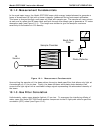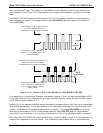
Model GFC7000E Instruction Manual MAINTENANCE SCHEDULE & PROCEDURES
04584 Rev A1 151
4. Pressurize the instrument with the leak checker, allowing enough time to fully pressurize the
instrument through the critical flow orifice. Check each fitting with soap bubble solution,
looking for bubbles. Once the fittings have been wetted with soap solution, do not re-apply
vacuum, as it will suck soap solution into the instrument and contaminate it. Do not exceed
15 psi pressure.
5. If the instrument has one of the zero and span valve options, the normally closed ports on
each valve should also be separately checked. Connect the leak checker to the normally closed
ports and check with soap bubble solution.
6. Once the leak has been located and repaired, the leak-down rate should be < 1 in-Hg (0.4 psi)
in 5 minutes after the pressure is shut off.
9.3.4. Performing a Sample Flow Check
CAUTION
Always use a separate calibrated flow meter capable of measuring flows
in the 0 – 1000 cc/min range to measure the gas flow rate though the
analyzer.
DO NOT use the built in flow measurement viewable from the Front Panel
of the instrument. This measurement is only for detecting major flow
interruptions such as clogged or plugged gas lines.
See Figure 3-2 for sample port location.
1. Turn off power.
2. Attach the Flow Meter to the sample inlet port on the rear panel. Ensure that the inlet to the
Flow Meter is at atmospheric f.
3. Turn on instrument power.
4. Sample flow should be 800 cc/min ± 10%.
5. Once an accurate measurement has been recorded by the method described above, adjust the
analyzer’s internal flow sensors (see Section 6.9.8)
Low flows indicate blockage somewhere in the pneumatic pathway. High flows indicate leaks
downstream of the Flow Control Assembly.
9.3.5. Cleaning the Optical Bench
The MGFC7000E sensor assembly and optical bench is complex and delicate. Disassembly and
cleaning is not recommended. Please check with the factory before disassembling the optical
bench.
9.3.6. Cleaning Exterior Surfaces of the MGFC7000E
If necessary, the exterior surfaces of the MGFC7000E can be cleaned with a clean damp cloth. Do
not submerge any part of the instrument in water or cleaning solution.


















